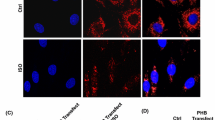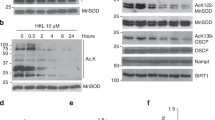Abstract
Objective
Hydrogen peroxide (H2O2), one of the oxyradical members, has been shown to have insulin-like effects, and endogenous H2O2 may have the ability to improve impaired glucose metabolism. As a mechanism contributing to progression of hypertrophy, we hypothesized that the formation of H2O2 to improve glucose uptake could be an oxidative stress resulting in apoptotic cell death.
Methods
We used cultured myoblasts (H9c2) stimulated by isoproterenol as a model to focus on glucose metabolism, oxidative stress, apoptosis, and extracellular signal-regulated protein kinases (ERKs) expression.
Results
In hypertrophied myoblasts, anaerobic glycolysis became prominent at day 7 of isoproterenol stimulation (ISO7; isoproterenol was administered for 7 days). Hydroperoxides production started to increase at day 5 of isoproterenol stimulation (ISO5) and peaked at ISO7. Apoptotic cell death was significantly increased in ISO5 and ISO7. Temporary ERKs suppression was also found at ISO5 and ISO7. Change in glucose metabolism led to stimulation of hydroperoxides production, apoptotic cell death and suppression of ERKs.
Conclusion
We concluded that oxidative stress was increased during the progression of hypertrophied myoblasts in association with impaired glucose metabolism and increased apoptotic cell death. Suppression of ERKs may be involved in signal transduction of apoptotic cell death.
Similar content being viewed by others
References
Singal PK, Kirshenbaum LA. A relative deficit in antioxidant reserve may contribure in cardiac failure. Can J Cardiol 1990;6:47–49.
Kono Y, Nakamura K, Kimura H, Nishii N, Watanabe A, Banba K, et al. Elevated levels of oxidative DNA damage in serum and myocardium of patients with heart failure. Circ J 2006;70:1001–1005.
Xia Y, Khatchikian G, Zweier JL. Adenosine deaminase inhibition prevents free radical-mediated injury in the postischemic heart. J Biol Chem 1996;271:10096–10102.
Dhalla AK, Hill MF, Singal PK. Role of oxidative stress in transition of hypertrophy to heart failure. J Am Coll Cardiol 1996;28:506–514.
Bishop SP, Altschuld RA. Increased glycolytic metabolism in cardiac hypertrophy and congestive failure. Am J Physiol 1970;218:153–159.
Taegtmeyer H, Overturf ML. Effects of moderate hypertension on cardiac function and metabolism in the rabbit. Hypertension 1988;11:416–426.
Takeuchi K, McGowan FX Jr, Glynn P, Moran AM, Rader CM, Cao-Danh H, et al. Glucose transporter upregulation improves ischemic tolerance in hypertrophied failing heart. Circulation 1998;98:II-234–241.
Marti L, Morin N, Enrique-Tarancon G, Prevot D, Lafontan M, Testar X, et al. Tyramine and vanadate synergically stimulate glucose transport in rat adipocytes by amine oxidasedependent generation of hydrogen peroxide. J Pharm Exp Ther 1998;285:342–349.
Li P-F, Dietz R, Von Harsdorff R. Differential effect of hydrogen peroxide and superoxide anion on apoptosis and proliferation of vascular smooth muscle cells. Circulation 1997;96:3602–3609.
Aikawa R, Komuro I, Yamazaki T, Zou Y, Kudoh S, Tanaka M, et al. Oxidative stress activates extracellular signal-regulated kinases through Src and Ras in cultured cardiac myocytes of neonatal rats. J Clin Invest 1997;100:1813–1821.
Yamazaki T, Komuro I, Zou Y, Kudoh S, Shiojima I, Hiroi Y, et al. Norepinephrine induces the raf-1 kinase/mitogenactivated protein kinase cascade through both α1-and β1-adrenoceptors. Circulation 1997;95:1260–1268.
Zou Y, Komuro I, Yamazaki T, Aikawa R, Kudoh S, Shiojima I, et al. Protein kinase C, but not tyrosine kinases or Ras, plays a critical role in angiotensin II-induced activation of Raf-1 kinase and extracellular signal-regulated protein kinases in cardiac myocytes. J Biol Chem 1996;271:33592–33597.
Choukroun G, Hajjar R, Kyriakis JM, Bonventre JV, Rosenzwieg A, Force T. Role of the stress-activated protein kinases in endothelin-induced cardiomyocytes hypertrophy. J Clin Invest 1998;102:1311–1320.
Thorburn J, Frost FA, Thornburn A. Mitogen-activated protein kinases mediate changes in gene expression, but not cytoskeletal organization associated with cardiac muscle cell hypertrophy. J Cell Biol 1994;126:1565–1572.
Thorburn J, McMahon M, Thorburn A. Raf-1 kinase activity is necessary and sufficient for gene expression changes but not sufficient for cellular morphology changes associated with cardiac myocyte hypertrophy. J Biol Chem 1994;269:30580–30586.
Gillespie-Brown J, Fuller SJ, Bogoyevitch MA, Cowley S, Sugden PH. The mitogen-activated protein kinase kinase MEK1 stimulates a pattern of gene expression typical of the hypertrophic phenotype in rat ventricular cardiomyocytes. J Biol Chem 1995;270:28092–28096.
Simpson P. Stimulation of hypertrophy of cultured neonatal rat heart cells through an α1-adrenergic receptor and induction of beating through an α1-and β1-adrenergic receptor interaction. Circ Res 1985;56:884–894
Bondar RJL, Mead DC. Evaluation of glucose-6-phosphate dehydrogenase from Leuconostoc mesenteroides in the hexokinase method for determining glucose in serum. Clin Chem 1974;20:586–590.
Gloster JA, Harris P. Observation on an enzymic method for the estimation of pyruvate in blood. Clin Chim Acta 1962;7:206–211.
Nakamura K, Fushimi K, Kouchi H. Inhibitory effects of antioxidants on neonatal rat cardiac myocyte hypertrophy induced by tumor necrosis factor-alpha and angiotensin II. Circulation 1998;98:794–799.
Xia Y, Khatchikian G, Zweier JL. Adenosine deaminase inhibition prevents free radical-mediated injury in the postischemic heart. J Biol Chem 1996;271:10096–10102.
Boveris A, Cadenas E, Stoppani AOM. Role of ubiquinone in the mitochondrial generation of hydrogen peroxide. Biochem J 1976;156:435–444.
McCord JM. Oxygen-derived radicals: a link between reperfusion injury and inflammation. Fed Proc 1987;46:2402–2406.
Friehs I, Morgan AM, Stamm C, Colan SD, Takeuchi K, Cao-Danh H, et al. Impaired glucose transporter activity in pressure-overload hypertrophy is an early indicator of progression to failure. Circulation 1999;100(suppl II):II-187–193.
Hiraishi H, Terano A, Ota S, Mutoh H, Razandi M, Sugimoto T, et al. Role for iron in reactive oxygen species-mediated cytotoxicity to cultured rat gastric mucosal cells. Am J Physiol 1991;260:G556–G563.
Goldhaber JI, Liu E. Excitation-contraction coupling in single guinea-pig ventricular myocytes exposed to hydrogen peroxide. J Physiol 1994;477:135–147.
Wei EP, Kontos HA. H2O2 and endothelium-dependent cerebral arteriolar dilation. Implications for the identity of endothelium-derived relaxing ractor generated by acetylcholine. Hypertension 1990;16:162–169.
Kirkland JB. Lipid peroxidation, protein thiol oxidation and DNA damage in hydrogen peroxide-induced injury to endothelial cells: role of activation of poly (ADP-ribose) polymerase. Biochim Biophys Acta 1991;1092:319–325.
Gottlieb RA, Burleson KO, Kloner RA, Babior BM, Engler RL. Reperfusion injury induces apoptosis in rabbit cardiomyocytes. J Clin Invest 1994;94:1621–1628.
Cheng W, Li B, Kajstura J, Li P, Wolin MS, Sonnenblick EH, et al. Stretch-induced programmed myocyte cell death. J Clin Invest 1995;96:2247–2259.
Author information
Authors and Affiliations
Corresponding author
Rights and permissions
About this article
Cite this article
Itoh, K., Minakawa, M., Ono, Y. et al. Role of oxidative stress in hypertrophied myoblasts stimulated by isoproterenol. Gen Thorac Cardiovasc Surg 56, 170–176 (2008). https://doi.org/10.1007/s11748-007-0214-7
Received:
Accepted:
Published:
Issue Date:
DOI: https://doi.org/10.1007/s11748-007-0214-7




